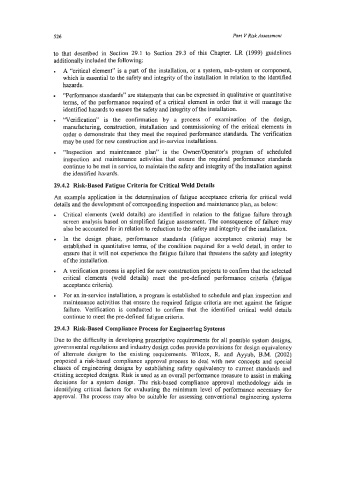Page 550 - Marine Structural Design
P. 550
526 Part V Risk Assessment
to that described in Section 29.1 to Section 29.3 of this Chapter. LR (1999) guidelines
additionally included the following:
A “critical element’’ is a part of the installation, or a system, sub-system or component,
which is essential to the safety and integrity of the installation in relation to the identified
hazards.
“Performance standards” are statements that can be expressed in qualitative or quantitative
terms, of the performance required of a critical element in order that it will manage the
identified hazards to ensure the safety and intesty of the installation.
“Verification” is the confirmation by a process of examination of the design,
manufacturing, construction, installation and commissioning of the critical elements in
order o demonstrate that they meet the required performance standards. The verification
may be used for new construction and in-service installations.
“Inspection and maintenance plan” is the OwnedOperator‘s program of scheduled
inspection and maintenance activities that ensure the required performance standards
continue to be met in service, to maintain the safety and integrity of the installation against
the identified hazards.
29.4.2 Risk-Based Fatigue Criteria for Critical Weld Details
An example application is the determination of fatigue acceptance criteria for critical weld
details and the development of corresponding inspection and maintenance plan, as below:
Critical elements (weld details) are identified in relation to the fatigue failure through
screen analysis based on simplified fatigue assessment. The consequence of failure may
also be accounted for in relation to reduction to the safety and integrity of the installation.
In the design phase, performance standards (fatigue acceptance criteria) may be
established in quantitative terms, of the condition required for a weld detail, in order to
ensure that it will not experience the fatigue failure that threatens the safety and integrity
of the installation.
A verification process is applied for new construction projects to confirm that the selected
critical elements (weld details) meet the pre-defined performance criteria (fatigue
acceptance criteria).
For an in-service installation, a program is established to schedule and plan inspection and
maintenance activities that ensure the required fatigue criteria are met against the fatigue
failure. Verification is conducted to confirm that the identified critical weld details
continue to meet the pre-defined fatigue criteria.
29.4.3 Risk-Based Compliance Process for Engineering Systems
Due to the difficulty in developing prescriptive requirements for all possible system designs,
governmental regulations and industry design codes provide provisions for design equivalency
of alternate designs to the existing requirements. Wilcox, R. and Ayyub, B.M. (2002)
proposed a risk-based compliance approval process to deal with new concepts and special
classes of engineering designs by establishing safety equivalency to current standards and
existing accepted designs. Risk is used as an overall performance measure to assist in making
decisions for a system design. The risk-based compliance approval methodology aids in
identifying critical factors for evaluating the minimum level of performance necessary for
approval. The process may also be suitable for assessing conventional engineering systems

